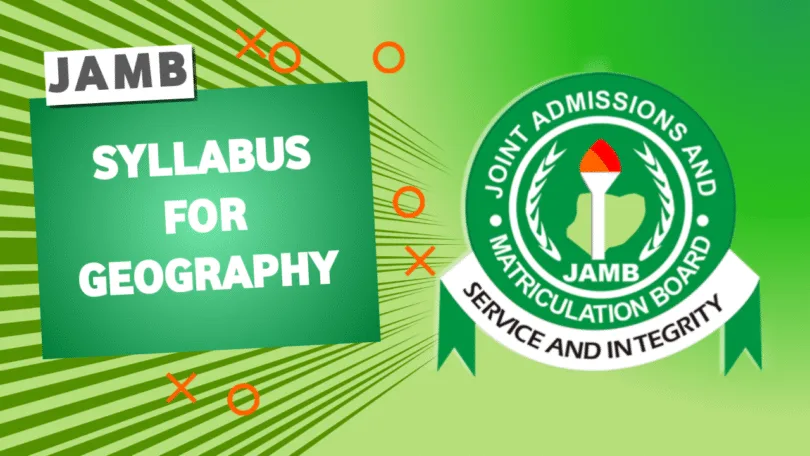In this article, we will be giving you a detailed guide on the JAMB Syllabus for Geography 2026/2027 and how to use it effectively. If Geography is one of the subjects you registered in your recent JAMB registration, here’s what you need to know.
JAMB Syllabus for Geography Overview
| Title | Detail |
|---|---|
| Exam Type | UTME |
| Exam Session | 2026/2027 |
| Syllabus Subject | Geography |
| File Format | |
| File Size | 185KB |
Why You Should Use The JAMB Syllabus for Geography ?
Here are reasons why we recommend you use the JAMB Syllabus for Geography 2026/2027. You already have a lot to study, so using the syllabus will;
- Help to improve your JAMB score because you did s well-targeted reading
- Help you to predict which topics are frequently tested
- Help you study smarter, not harder
- Help you study efficiently instead of blindly
- Help to know which topics are interrelated to one another
Topics Covered in the JAMB Syllabus for Geography
- Maps
- Scale and Measurement
- Map Reading and Interpretation
- Interpretation of Statistical Data
- Elementary Surveying
- Geographic Information System (GIS)
- The Earth as a Planet
- The Earth’s Crust
- Volcanism and Earthquakes
- Denudation Processes in the Tropics
- Water Bodies
- Weather and Climate
- Vegetation
- Soils
- Environmental Resources
- Environmental Interaction
- Environmental Hazards
- Environmental Conservation
- Population
- Settlement (with particular reference to Western Europe, the USA, the Middle East, and West Africa)
- Selected Economic Activities
- Broad Outline of Nigeria
- Economic and Human Geography
- ECOWAS
Full JAMB Syllabus for Geography 2026/2027
| Section | Topics / Contents | Objectives (What Candidates Should Be Able To Do) |
|---|---|---|
| General Objectives |
The aim of the Geography UTME syllabus is to prepare candidates for the Board’s examination. It is designed to test their achievement of the following objectives:
| |
| I. Practical Geography |
|
|
| II. Physical Geography |
|
|
| III. Human Geography |
|
|
| IV. Regional Geography |
|
|
Sources
- Integrated Brochure And Syllabus System (IBASS)
- Myschool.ng
How To Download The JAMB Geography Syllabus 2026/2027
Follow the steps listed below if you want to download the JAMB Geography syllabus.
- To access the file, tap the download link on this page
- Save the PDF to your mobile phone or laptop so you can access it anytime, even without data
- The PDF makes it easier to plan for reading, organizing, and tracking your progress.
Best Ways For Using The JAMB Geography Syllabus Effectively
- Allocate more revision time to topics that you noticed appear more often
- Cross-check the syllabus every week to see how much you’ve covered
- Ensure you are not just cramming. You need to understand what each topic is all about
- Do not forget to go over the syllabus again a few days before the exam
- Ensure you use the updated syllabus because it changes sometime
Conclusion
In conclusion, candidates are advised to use this syllabus as a guide while studying. They should also try to answer questions on each topic on the go.
FAQs on JAMB Geography Syllabus 2026
Is the JAMB Syllabus Compulsory?
Yes. The JAMB Geography Syllabus is compulsory if you want your studying to be worthwhile. You need to ensure you are on the right track and that is what the syllabus is offering.
Can I Download The JAMB Geography Syllabus for Free?
Yes, you can. The JAMB Geography Syllabus can be downloaded for free right here on the website.
Does JAMB Syllabus Changes Every Year?
Not exactly. Sometimes, it changes and sometimes, it doesn’t. You need to ensure that you are up to date to know whichever one they are using currently.
How Many Questions Come From Geography in JAMB?
Usually 40 questions
Where Can I Get The Official JAMB Geography Syllabus 2026?
You can get the Official JAMB Geography Syllabus for 2026 here





